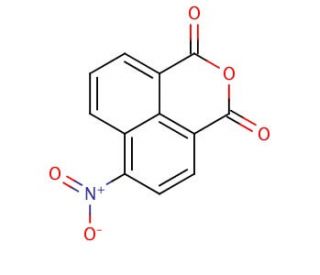

Molecular structure of 4-Nitro-1,8-naphthalic anhydride, CAS Number: 6642-29-1
4-Nitro-1,8-naphthalic anhydride (CAS 6642-29-1)
Alternate Names:
4-Nitronaphthalene-1,8-dicarboxylic anhydride
CAS Number:
6642-29-1
Molecular Weight:
243.17
Molecular Formula:
C12H5NO5
For Research Use Only. Not Intended for Diagnostic or Therapeutic Use.
* Refer to Certificate of Analysis for lot specific data.
QUICK LINKS
Ordering Information
Description
Technical Information
Safety Information
SDS & Certificate of Analysis
4-Nitro-1,8-naphthalic anhydride (4-NNA) is a type of organic compound belonging to the family of naphthalic anhydrides. It is widely used in scientific research as a building block for the synthesis of various organic compounds. It is employed in the production of polymers, agrochemicals, and dyes. It is also used in the synthesis of new materials with interesting properties, such as shape-memory polymers.
4-Nitro-1,8-naphthalic anhydride (CAS 6642-29-1) References
- Assessment of 4-nitro-1,8-naphthalic anhydride reductase activity in homogenates of bakers' yeast by reversed-phase high-performance liquid chromatography. | Xu, J., et al. 2007. J Chromatogr B Analyt Technol Biomed Life Sci. 847: 82-7. PMID: 17070119
- Biotransformation of nitro-polycyclic aromatic compounds by vegetable and fruit cell extracts. | Xie, B., et al. 2012. J Zhejiang Univ Sci B. 13: 248-53. PMID: 22467365
- A colorimetric and fluorescent dual probe for specific detection of cysteine based on intramolecular nucleophilic aromatic substitution. | Ma, L., et al. 2012. Analyst. 137: 5046-50. PMID: 22970425
- A supramolecular Tröger's base derived coordination zinc polymer for fluorescent sensing of phenolic-nitroaromatic explosives in water. | Shanmugaraju, S., et al. 2017. Chem Sci. 8: 1535-1546. PMID: 28572910
- Informing Efforts to Develop Nitroreductase for Amine Production. | Miller, AF., et al. 2018. Molecules. 23: PMID: 29364838
- Biochemical characteristics of a nitroreductase with diverse substrate specificity from Streptomyces mirabilis DUT001. | Yang, J., et al. 2019. Biotechnol Appl Biochem. 66: 33-42. PMID: 30231196
- Squaramide-Naphthalimide Conjugates as 'Turn-On' Fluorescent Sensors for Bromide Through an Aggregation-Disaggregation Approach. | Kumawat, LK., et al. 2019. Front Chem. 7: 354. PMID: 31192187
- Self-Assembly Controls Reactivity with Nitric Oxide: Implications for Fluorescence Sensing. | Felip-León, C., et al. 2018. ACS Omega. 3: 15538-15545. PMID: 31458209
- Spectral Characteristics and Sensor Ability of a New 1,8-Naphthalimide and Its Copolymer with Styrene. | Staneva, D., et al. 2020. Sensors (Basel). 20: PMID: 32575857
- Effect of an alkyl spacer on the morphology and internalization of MUC1 aptamer-naphthalimide amphiphiles for targeting and imaging triple negative breast cancer cells. | Kuang, H., et al. 2021. Bioeng Transl Med. 6: e10194. PMID: 33532593
- A Nitronaphthalimide Probe for Fluorescence Imaging of Hypoxia in Cancer Cells. | Kumari, R., et al. 2021. J Fluoresc. 31: 1665-1673. PMID: 34383168
- Synthesis and photophysical properties of photostable 1,8-naphthalimide dyes incorporating benzotriazole-based UV absorbers. | Uesaka, T., et al. 2022. RSC Adv. 12: 17350-17361. PMID: 35765430
- Enhanced Photodynamic Efficacy Using 1,8-Naphthalimides: Potential Application in Antibacterial Photodynamic Therapy. | Staneva, D., et al. 2022. Molecules. 27: PMID: 36144479
- Synthesis, spectral characterization, and theoretical investigation of the photovoltaic properties of (E)-6-(4-(dimethylamino)phenyl)diazenyl)-2-octyl-benzoisoquinoline-1, 3-dione. | Ofem, MI., et al. 2022. BMC Chem. 16: 109. PMID: 36463218
- Self-Associated 1,8-Naphthalimide as a Selective Fluorescent Chemosensor for Detection of High pH in Aqueous Solutions and Their Hg2+ Contamination. | Said, AI., et al. 2022. Sensors (Basel). 23: PMID: 36616999
Ordering Information
| Product Name | Catalog # | UNIT | Price | Qty | FAVORITES | |
4-Nitro-1,8-naphthalic anhydride, 5 g | sc-232906 | 5 g | $214.00 |
